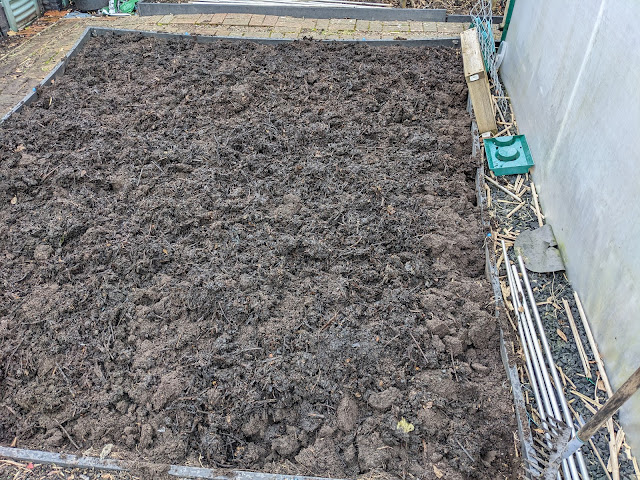As a general rule, I plant my onion sets in March and my chitted seed potatoes in April. This year I planted both on March 31st - the onion sets had only arrived a few days earlier (i.e. much later than normal) whilst the potatoes had been chitting away since mid-February and were ready for planting during the mild weather at the end of March/beginning of April.
Onion Sets
Usually, I grow a bag of white and a bag of red onions and these, when stored correctly, will last for a whole year. This year, however, I have decided to go with just one bag of red onions (Red Baron, as in previous years) and grow a few different vegetables instead.
 |
| Photo 1: Red Baron Onion Sets |
 |
| Photo 2: Checking for baduns |
 |
| Photo 3: Preparing the bed for onion planting |
 |
| Photo 4: Onion Fly Protection |
Seed Potatoes
This year I have opted for a different variety - Premiere - as used by McCain! Though I'm not sure which MaCain product (baked potatoes, chips or fries, hash browns, roast, wedges, mash ...) these are recommended for:
 |
| Photo 5: McCain Premiere Seed Potatoes |
Premiere is a first-early variety so should be ready for harvesting during the summer (July). By not leaving them in the ground, I hope to avoid many of the pests and diseases that afflict potatoes.
The seed potatoes arrived mid-February and were unpacked before laying out on paper (ex-Amazon packaging) in plastic trays (ex-mushroom containers) for chitting in a frost-free light area (cooler part of the house next to a west-facing window) - Photo 6.
 |
| Photo 6: Chitting Premiere Seed Potatoes (16th February 2023) |
Chitting takes about 6 weeks so there was plenty of time to prepare the ground for planting the potatoes at the end of March.
This year I used a different planting regime. Last year, I added unsieved compost to the potato trench, after placing the seed potatoes in position, before overfilling with soil. This year, because I had to clear out one of my 'mature' compost bins early (mid-March), I decided to layer the unsieved compost on top of the soil rather than use it as a trench fill material.
Stage 1: In mid-March, hand weed the plot, turn over the soil (one spade's depth), and add trugfuls of unsieved compost - working backward across the plot (Photo 7):
 |
| Photo 7: Remove weeds, turn over, and add compost (18th March 2023) |
 |
| Photo 8: Compost-covered Potato Patch (18th March 2023) |
 |
| Photo 9: Cat-proofing the Potato Plot (18th March 2023) |
Meanwhile, the seed potatoes had gone had chitted nicely (Photo 10) and were ready for planting out, weather permitting:
 |
| Photo 10: Chitted Potatoes Ready for Planting Out |
This year, I dug a 15 cm (6") trench, positioned the chitted potatoes in it (Photo 11), and overfilled with soil (Photo 12):
 |
| Photo 11: Chitted Potatoes all in a Row |
 |
| Photo 12: Four Rows of Potatoes (Eight or Nine Spuds per Row) |
 |
| Photo 13: Potato Grow Bags for the Spares |
Sweetcorn will be grown on the same plot as the potatoes. Like onions, potatoes need very little in the way of care and attention. Water in dry periods and earth up the rows on a regular basis to encourage more tubers and protect against late frosts. I will include extra compost when earthing up the rows and give an occasional feed with comfrey tea. As the leaves and shoots break through the soil surface in the potato grow bags, extra soil/compost is added until the bag is full - regular watering is very important with grow bags..






0 comments:
Post a Comment